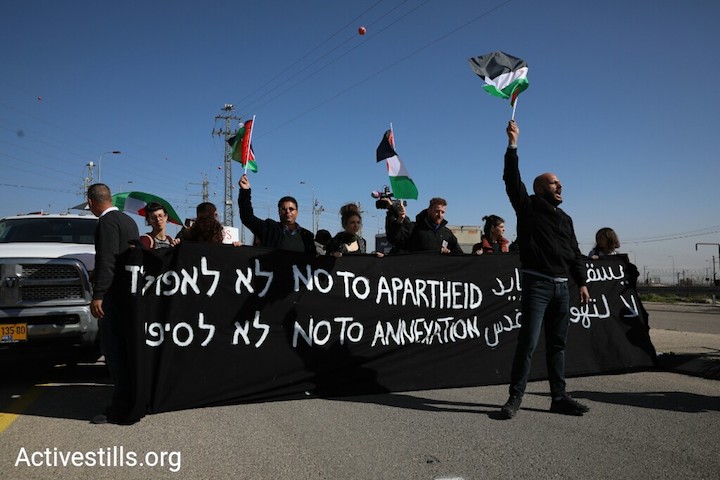Activists say the highway, which separates Israeli and Palestinian traffic with an 26-foot concrete wall, will ‘strengthen Israeli rule, including by shutting out entire Palestinian areas.’

Dozens of Palestinian, Israeli, and international activists Wednesday morning blocked a highway many have dubbed the “apartheid road,” Route 4370 in the occupied West Bank, which separates Israeli and Palestinian traffic with an 26-foot concrete wall.
The activists managed to shut down the highway for 20 minutes before Israeli Border Police officers suppressed the demonstration with stun grenades and arrested two.
One side of the road, which stretches between Route 437 and Route 1 just east of Jerusalem in the West Bank, is designated for Israeli citizens and the other, separated by the concrete wall, for Palestinians. The Israeli side allows easy access to central Jerusalem, while the other side is designed to funnel Palestinians through an underpass, so as to not disturb Israeli traffic into the city.
“We came here to protest against yet another apartheid road,” said Sahar Vardi, one of the organizers of the protest. “There are a number of such roads that separate Israelis and Palestinians, but on this road you see a wall in the middle, symbolizing the polices of the occupation.”
The official reasoning for opening the road was to alleviate traffic for Israeli settlers commuting to Jerusalem, as well as creating a new way for Palestinians to travel between the northern and southern West Bank. According to Vardi, the true goal of the highway is to help the settlers and “strengthen Israeli rule, including by shutting out entire Palestinian areas.”

Palestinians and human rights activists say the highway is part of plan to create territorial contiguity between Jerusalem and its surrounding settlements, particularly the highly-contested E1 area, the 12 sq. kilometer area located between Jerusalem and the West Bank settlement of Ma’ale Adumim. For decades, Israel has hoped to build up the area with settlements, connecting the settlement to Jerusalem and effectively bifurcating the West Bank.
“Every effort to improve the lives of Palestinians is done first and foremost for the sake of control and the settlers. This is what we are witnessing,” Vardi said.
“This is a clear example of apartheid,” said Israeli activist Karen Isaacs. “Aside from the physical separation between Palestinians and Israelis, the goal is to annex this entire area to Jerusalem. We blocked this road to send a message that this is not a normal situation.”
This article was first published in Hebrew on Local Call. Read it here.

